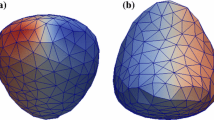Abstract
We consider weakly singular integral equations of the first kind on open surface pieces Γ in ℝ3. To obtain approximate solutions we use theh-version Galerkin boundary element method. Furthermore we introduce two-level additive Schwarz operators for non-overlapping domain decompositions of Γ and we estimate the conditions numbers of these operators with respect to the mesh size. Based on these operators we derive an a posteriori error estimate for the difference between the exact solution and the Galerkin solution. The estimate also involves the error which comes from an approximate solution of the Galerkin equations. For uniform meshes and under the assumption of a saturation condition we show reliability and efficiency of our estimate. Based on this estimate we introduce an adaptive multilevel algorithm with easily computable local error indicators which allows direction control of the local refinements. The theoretical results are illustrated by numerical examples for plane and curved surfaces.
Similar content being viewed by others
References
Bergh, J., Löfström, J.: Interpolation spaces. Berlin Heidelberg New York: Springer 1976.
Bornemann, F., Kornhuber, R.: Adaptive multilevel methods in three space dimensions. Int. J. Numer. Meth. Eng.36, 3187–3203 (1993).
Cao, T.: Adaptive and additive multilevel methods for boundary integral equations. Thesis, School of Mathematics, University of New South Wales, Sydney, Australia, 1995.
Dahlke, S., Dahmen, W., Hochmuth, R., Schneider, R.: Stable multiscale bases and local error estimation for elliptic problems. Preprint, TH Aachen, 1995.
Deuflhard, P., Leinen, P., Yserentant, H.: Concepts of an adaptive hierarchical finite element code. Impact Comput. Sci. Eng.1, 3–35 (1989).
Funken, S. A.: Schnelle Lösungsverfahren für FEM-BEM Kopplungsgleichungen. PhD thesis, Institut für Angewandte Mathematik, Universität Hannover, 1996.
Grisvard, P.: Elliptic problems in nonsmooth domains. Boston: Pitman 1985.
Heuer, N., Maischak, M., Stephan, E. P.: Thehp-version of the boundary element method for screen problems. Preprint, Universität Hannover (submitted for publication).
Mund, P.: On the implementation of theh-p-boundary element method on curved surfaces. In: Hackbusch, W., Wittum, G. (eds.) Boundary elements: Implementation and Analysis of Advanced Algorithms. Proceedings of the 12th GAMM-Seminar Kiel, 1996. Notes on Numerical Fluid Mechanics Vol. 54. Vieweg, Braunschweig, 1996, 182–193.
Oswald, P.: Multilevel-splitted norms forH −1/2, Preprint, Institute for Algorithms and Scientific Computing, GMD, Sankt Augustin, Germany, 1997.
von Petersdorf, T.: Randwertprobleme der Elastizitätstheorie für Polyeder — Singularitäten und Approximation mit Randelementmethoden. Thesis, Technische Hochschule Darmstadt, 1989.
Stephan, E. P.: Boundary integral equations for screen problems in ℝ3. J. Integr. Equations Oper. Theory10, 236–257 (1987).
Author information
Authors and Affiliations
Additional information
Supported by the German Research Foundation (DFG) under grant Ste 238/25-9.
Rights and permissions
About this article
Cite this article
Mund, P., Stephan, E.P. & Weiße, J. Two-level methods for the single layer potential in ℝ3 . Computing 60, 243–266 (1998). https://doi.org/10.1007/BF02684335
Received:
Revised:
Issue Date:
DOI: https://doi.org/10.1007/BF02684335




